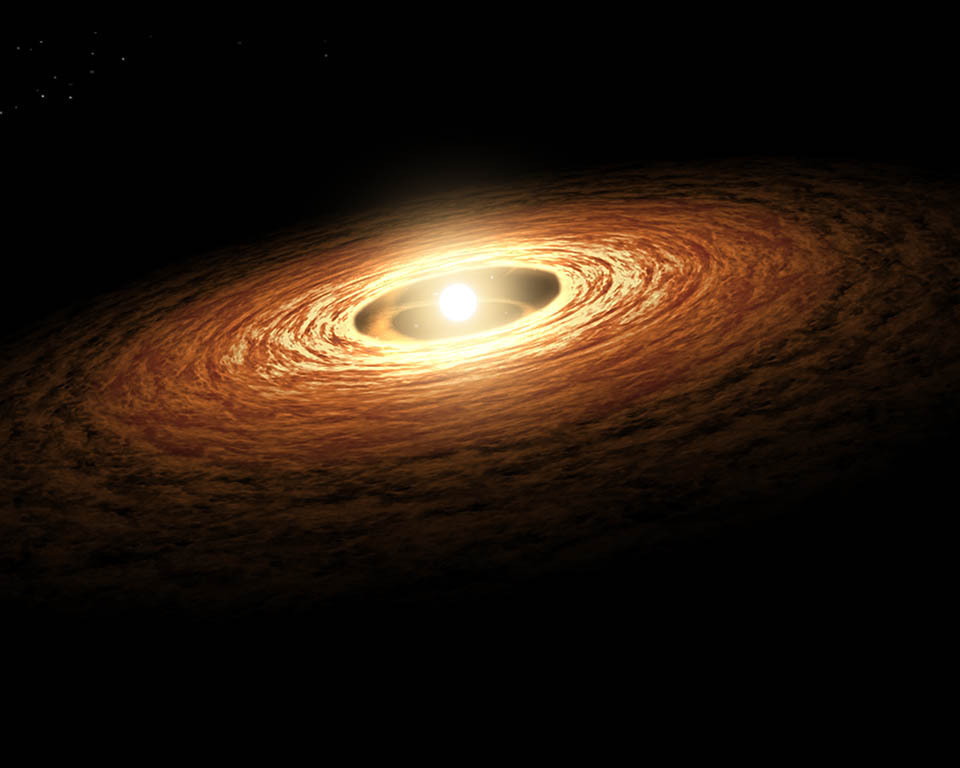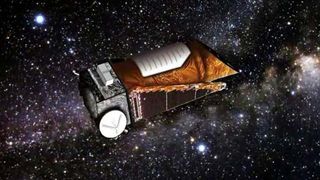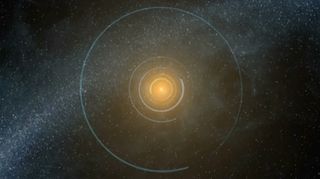When Did the Universe Have the Right Stuff for Planets?

To build a planet you need lots of rubble and that means lots of heavy elements – stuff more massive than atoms of hydrogen and helium. The elemental composition of the collapsing nebula that gave birth to the Sun and the planets of the Solar System included things like iron, silicon and magnesium that form the bulk of rocky planets, and carbon, oxygen, nitrogen, potassium and other such elements that are essential for life.
However, these materials were present in just trace quantities, amounting to no more than two percent of the entire nebula that was otherwise dominated by hydrogen (74 percent) and helium (24 percent). Yet this gaseous cloud was huge; it is estimated that it harbored enough heavy elements to build at least thirty planets like Earth.
These heavy elements – 'metals' in astronomer-speak – don't just materialize out of nothing. They are the products of fusion power within stars, subsequently spewed out across the cosmos on the blast waves of supernovae, lacing the interstellar medium with the raw ingredients for planets. To build up enough of these materials, many stars must first live and die, each one contributing to the evolving chemistry of the universe, but how much material is really required to build a planet and how quickly did the universe accrue a sufficient level to do so?
Heavy Metal Planets
Earth was born out of the debris of a protoplanetary disc around a nascent Sun 4.54 billion years ago – a serious chunk of time in anybody's book. Yet the universe is 13.7 billion years old – the Solar System has been around for just the last third of cosmic history. Is it possible that rocky planets could have formed around other stars much earlier? Are we the new kids on the block by comparison?
Until recently, we didn't think so. The prevailing wisdom had been that the magic of stellar alchemy didn't produce enough useful "star-stuff" to build terrestrial worlds until at least six or seven billion years after the Big Bang. Initial studies of exoplanets backed this up, finding worlds around stars with a "metallicity" (i.e. a heavy element abundance) equal to or greater than our Sun. However, it turns out that the biases that affected our early planet hunting also skewed our understanding of the types of stars that could form planets. Until 2009 and the launch of NASA's Kepler mission, the vast majority of exoplanets known to exist were gas giants close to their stars, simply because these were the easiest to detect. These planets seemed to prefer higher metallicity stars.

Kepler, however, has changed the way we view exoplanets. Simply by observing so many all at once in its field-of-view, the space telescope is taking an unprecedented census of alien worlds. It has found 2,321 candidate planets to date, over a third of which are smaller, rocky planets (Jupiter-sized gas giants or larger make up just 11 percent, with the rest being Neptune-sized worlds of indeterminate nature), whereas before Kepler you could count the number of rocky exoplanets discovered on one hand. Follow-up studies of their host stars have since revealed a surprising discovery. [Gallery: A World of Kepler Planets]
Get the Space.com Newsletter
Breaking space news, the latest updates on rocket launches, skywatching events and more!
"We found that the existence of small planets does not depend as strongly on the metallicity of their star as is the case for the larger planets," says Lars Buchhave of the Niels Bohr Institute at the University of Copenhagen. Buchhave is lead author of a new study involving a multinational group of astronomers investigating the spectra of 150 stars that play host to 226 candidate planets found by Kepler. Their research was initially presented at the 220th meeting of the American Astronomical Society in Anchorage, Alaska this June, followed by a paper in Nature.
"At first glance it appears very counter-intuitive that gas giants should be the ones caring about metallicity and terrestrial planets less so," says Anders Johansen of Lund Observatory in Sweden, who was a co-author on the Buchhave paper. Only when you stop to consider how planets are constructed does it begin to make sense. The process of accreting hierarchically from smaller building blocks is termed core accretion, but there has been something of a debate surrounding gas giants like Jupiter. Can they condense straight out of the gas of the solar nebula like a star, or do they need a large seed around which to grow by rapidly gathering gas from the protoplanetary disc in a runaway process?
The preference of gas giants for higher metallicity stars indicates that they formed through core accretion, building up a central rocky core ten times the mass of Earth that could dominate the protoplanetary disc and sweep up much of the gas before it dissipates after around ten million years. In lower metallicity systems there would not be enough heavy elements to build up large cores, leaving only small rocky worlds. As such, Johansen suggests that one way of looking at terrestrial planets is to see them as failed gas giant cores.
Limits to Life
Planetary systems around stars possessing a deficiency in heavy elements might prove to be attractive locales to search for life because, without the presence of gas giants, life might have an easier time of it. Most of the extra-solar gas giants that we have discovered are so-called 'hot Jupiters' located very close to their stars and completing an orbit in just a few days. These planets were not born this close, instead they migrated in-system from their birth orbits. Johansen says that more and more astronomers are coming around to the idea that such migration is forced by the gravitational pull and dynamical friction of the gas, or by close encounters with other planets. These interactions with fellow constituents of the protoplanetary disc removed angular momentum from the planets, often causing them to spiral towards their stars. Any smaller planets unfortunate to be in their way are thrown out of the system by the marauding gas giant.
"If a Jupiter-type planet migrates and in the process scatters all the smaller planets away, one should probably look for terrestrial planets elsewhere," says Buchhave. Life may have had a more pleasant ride in the early universe when, thanks to the lower metallicity, there were no gas giants – and the argument that Jupiter-sized planets are needed as a shield against comet impactors no longer holds water either. Life can do without gas giant planets.
If Earth-sized planets do not require stars with high abundances of heavy elements, then that has huge implications, expanding the possible abodes for life throughout both space and time. Consider: galaxies tend to evolve chemically from the inside out, with the highest abundances of heavy elements closer to the galactic center than in the outskirts of the spiral arms. Under the previous paradigm, the outer regions of the spiral arms were effectively the badlands, incapable of building planets or life. Yet when metallicity is no longer such a big issue, the galactic habitable zone – a region where environmental conditions including the metallicity and the rate of supernovae conspire to make habitable planets possible – suddenly widens to encompass much wider swathes of a galaxy.
Now consider that the abundance of heavy elements in the universe has grown over history. In the past the average metallicity would be quite a bit less. Again, under the previous paradigm this had been assumed to preclude rocky planet formation early in the universe, but now we know that such planets could have been constructed in environments that contained much poorer levels of heavy elements. This means that planets that could potentially have supported life may have formed eight, ten, maybe even twelve billion years ago.
Surveys do detect a decrease in the number of planet-hosting stars with decreasing metallicity, but this drop is much shallower for terrestrial planets than it is for gas giants. Of course, the presence of some heavy elements during the planet-building phases is required, but the minimum level has not yet been determined.
"I expect there will be a lower limit," says Johansen. "Simply because below a threshold metallicity there is not enough building material to form Earth-mass planets." Clearly, a heavy element abundance a tenth of the Sun's or less would struggle to build any planets. However, each galaxy evolves differently and there is no way to say for sure when the Milky Way crossed this threshold, although it is likely to have been early in the history of the universe, for the young cosmos was particularly adept at producing multiple generations of stars in quick succession. Star-formation rates of 4,000 solar masses per year have been measured less than a billion years after the Big Bang, compared to the paltry ten solar masses of gas converted into stars each year in the Milky Way.
"A typical massive star that exploded and released heavy elements 10 to 12 billion years ago had a metallicity of about a tenth of the Sun," adds Johan Fynbo, Professor of Cosmology at the Niels Bohr Institute. "But whenever you have a new generation of stars then you start enriching the interstellar gas with heavy elements." [The Strangest Alien Planets (Gallery)]
The Fermi Paradox
So, rocky planets around more stars, across greater expanses of the Milky Way and going back deeper in time than we had ever dreamt adds more fuel to the fire of the Fermi Paradox. First voiced by the brilliant nuclear physicist Enrico Fermi in 1950, the Fermi Paradox questions why, given all the stars and planets out there coupled with the huge age of the universe, have no alien civilizations encountered Earth yet? Where are they all?
The problem is made even worse when you consider that the first term in the Drake Equation – Frank Drake's method for estimating the number of intelligent civilizations in the Galaxy – is the star formation rate, which on average was much higher in the universe 10 to 13 billion years ago when it seems planets could first begin forming. In the Milky Way today the average annual star formation rate is ten solar masses; an order of ten or one hundred greater has the effect of bumping up the product of the equation: the estimated number of civilizations.
One of the favorite counter-arguments to the Fermi Paradox was that the threshold metallicity takes time to build up, resulting in the Sun being one of the first stars at the required level and hence Earth would be one of the first planets with life. Now we see that planets and possibly life could have arisen at practically any point in cosmic history, undermining this counter-argument and once again forcing us to ask, where is everybody? If life did first appear on worlds 12 to13 billion years ago, then intelligent civilizations (if indeed they survived all this time) would now billions of years ahead of us and their concerns may no longer include the happenings on a damp mudball somewhere in the galactic hinterlands. Perhaps civilizations that are many billions of years old instead spend their time siphoning energy from black holes or living inside Dyson Spheres.
There are, however, some twists in the tale. In 2010 researchers at the Max Planck Institute for Astronomy in Heidelberg, Germany, found a gas giant planet around a star so lacking in heavy elements that it must have formed very early in the history of the universe. To add to the intrigue, the star, known as HIP 13044 and located 2,000 light years away, is part of a stellar stream that is all that remains of a dwarf galaxy that has been cannibalized by the Milky Way. This year, the same researchers found another low metallicity star with two gas giants. Based on its abundance of hydrogen and helium the star, known as HIP 11952, was born 12.8 billion years ago, a mere 900 million years after the Big Bang. Why gas giants have been able to form around these heavy-metal deficient stars is unknown, perhaps hinting at an alternative process for gas planet formation.
On the other hand new results suggest that, in some regions of the universe at least, gas giants have been able to form all along.
Elemental Abundance
For some faint galaxies in the distant universe, whose light is too feeble to allow a measurement of their spectra, it is possible to cheat by making use of natural backlights such as highly luminous quasars to probe faint foreground galaxies. When taking advantage of this method to study the chemical composition of a galaxy that existed 12 billion years ago, a team of astronomers including Johan Fynbo made a rather surprising revelation.
"We looked at a background quasar whose light was passing through a galaxy in front of it, where the light of the quasar was absorbed," says Fynbo. "This allowed us to see the absorption lines from oxygen, sulphur, carbon and all the elements that have been synthesized in the galaxy."
Twelve billion years ago the chemistry of galaxies should have been fairly primitive, yet in this one particular galaxy Fynbo and his colleagues, who reported on their findings in Monthly Notices of the Royal Astronomical Society, found abundances of heavy elements equivalent to the abundance in the Sun. Such finds at high distances are not unusual in themselves, but they tend to occur within the hearts of quasars, across a very small area of a galaxy. In this instance, however, the quasar light was shining through the disc of the foreground galaxy revealing the solar levels of heavy elements 52,000 light years from the center, right in the outskirts. Even today our own Milky Way isn't so heavily chemically processed to the edge of its spiral arms, so how did this distant galaxy become so enriched throughout its full extent so quickly?
The best explanation so far is that a starburst – a ferociously rapid bout of star formation – within the inner regions of the galaxy has blown the heavy elements into the galactic outlands. This can be done simply though the gale force stellar winds of radiation emanating from hot, massive stars, or riding on the shock waves of supernovae. Furthermore, the quasar light was reddened by intervening dust in the galaxy. Dust is the most basic building block of planet formation, coming together in conglomerations and clumps that build up into protoplanets. Dust is also a product of the violent bombardment phase endured by young planetary systems and is copiously manufactured in supernovae.
"In order to make planets you clearly need metals and that seems to be possible quite far out in a galaxy at a very early time, which is what surprised us," says Fynbo. However, such high metallicities enables gas giant planets to also form but, although Lars Buchhave has mentioned what difficulties gas giants can cause for habitable planets, they don't necessarily have to be a show-stopper and our Solar System with Jupiter and Saturn is not the only exception.

"In the Kepler-20 planetary system there are five planets," he says, "Three are Saturn-sized planets and two are terrestrial-sized, with the order being big–small–big–small–big. If the Saturn-mass planets migrated in, how can the small planets be in-between the larger ones?'
Regardless, one thing is becoming clear: that sufficient raw materials for building terrestrial planets were available very soon after the Big Bang, raising the possibility that there could be life in the universe far older than we. Perhaps they reside around long-lived red dwarf stars, or have moved on from their home system after their star expired. Or, perhaps, we really are the first, which means that if life has happened just once throughout the entire history of the universe, our existence must be a fluke and our planet very, very special indeed.
Join our Space Forums to keep talking space on the latest missions, night sky and more! And if you have a news tip, correction or comment, let us know at: community@space.com.

Keith Cooper is a freelance science journalist and editor in the United Kingdom, and has a degree in physics and astrophysics from the University of Manchester. He's the author of "The Contact Paradox: Challenging Our Assumptions in the Search for Extraterrestrial Intelligence" (Bloomsbury Sigma, 2020) and has written articles on astronomy, space, physics and astrobiology for a multitude of magazines and websites.
